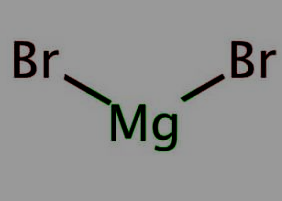
Magnesium Bromide Formula: Magnesium (Mg) is an elemental substance classified within Group 2 (IIa) of the Periodic Table, specifically among the alkaline earth metals. It boasts an atomic number of 12 and stands as the lightest structural metal. Compounds containing magnesium find extensive utility in both construction and medical fields. Furthermore, magnesium is an essential component within the cellular structure of all living organisms.
Bromine, conversely, is an element belonging to Group 17 (Group VIIA) and is characterized by an atomic number of 35. Designated by the chemical symbol "Br," bromine exists as a toxic crimson-hued liquid, classifying it as a halogen element.
Magnesium bromide, the product of combining bromine and magnesium, is represented by the chemical formula MgBr2. It is obtainable in two distinct forms: the anhydrous variety, presenting as white hygroscopic crystals, and the hexahydrate form, which manifests as colorless monoclinic crystals.
Also Check - Periodic Acid Formula
Magnesium Bromide Structure
The structure of magnesium bromide derives from the ionic bonding between the metal (magnesium) and nonmetal (bromine), yielding an ionic compound known as magnesium bromide. It's important to note that the proper formation of magnesium bromide necessitates the use of pure magnesium in conjunction with pure bromine.
 The preparation of magnesium bromide can occur through various chemical reactions:
Magnesium reacts with bromine:
Mg + Br
2
→ MgBr
2
Magnesium oxide reacts with hydrogen bromide acid:
MgO + HBr → MgBr
2
+ H2O
Magnesium carbonate reacts with hydrogen bromide acid:
MgCO
3
+ HBr → MgBr
2
+ CO
2
+ H
2
O
The preparation of magnesium bromide can occur through various chemical reactions:
Magnesium reacts with bromine:
Mg + Br
2
→ MgBr
2
Magnesium oxide reacts with hydrogen bromide acid:
MgO + HBr → MgBr
2
+ H2O
Magnesium carbonate reacts with hydrogen bromide acid:
MgCO
3
+ HBr → MgBr
2
+ CO
2
+ H
2
O
Also Check - Ionic Compound Formula
Magnesium Bromide Properties
Physical properties of magnesium bromide include its molecular and chemical formula, MgBr2, with a molecular weight of 184.113 g/mol for the anhydrous form. It appears as a white substance with a density of 3.72 g/cm3 (anhydrous), a melting point of 711 °C, and a boiling point of 1250 °C.
Chemically, when magnesium bromide interacts with chlorine, it produces magnesium chloride and bromine:
MgBr 2 + Cl 2 → MgCl 2 + 2Br Similarly, when sodium hydroxide reacts with magnesium bromide, it yields magnesium hydroxide and sodium bromide as products: 2NaOH + MgBr 2 → Mg(OH) 2 + 2NaBr Additionally, magnesium bromide reacts with water to generate magnesium ions and chloride ions as products: MgBr 2 + H 2 O → Mg 2+ + Br –Also Check - Lithium Oxide Formula
Magnesium Bromide Applications
Magnesium Bromide exhibits a diverse array of applications, underscoring its versatile utility:
Catalyst: This compound functions as a catalyst, catalysing various chemical reactions and facilitating their progression, thereby playing a pivotal role in numerous industrial and laboratory processes.
Position-Specific Triglyceride Analysis: It finds application in the meticulous analysis of triglycerols, enabling researchers and scientists to gain insights into the composition and structure of these vital compounds.
Anticonvulsant in Neuropathy Treatment: Widely recognized for its anticonvulsant properties, Magnesium Bromide plays a crucial role in the medical field, particularly in the treatment of neuropathy, a condition characterized by nerve-related disorders.
Mild Sedative Agent: Beyond its sedative attributes, it is also employed as a mild sedative, addressing scenarios where a gentle calming effect is required.
Flame Retardant: With its fire-suppressing qualities, Magnesium Bromide serves as an effective flame retardant, enhancing safety in various settings where fire hazards are a concern.
Magnesium (Mg) and Bromine (Br) are two distinct elements with unique properties and characteristics. Magnesium is an essential component in the natural world, serving as a vital structural metal and a fundamental element within living organisms. In contrast, Bromine is a halogen element, existing as a crimson-coloured liquid and known for its toxicity.
When these elements combine, they form Magnesium Bromide ( MgBr 2 ), a compound with versatile applications. It can be prepared through various chemical reactions and can exist in different physical forms. Its utility ranges from acting as a sedative and catalyst to facilitating triglyceride analysis and playing a crucial role in neuropathy treatment. Additionally, it serves as a flame retardant, enhancing safety in environments prone to fire hazards.
The significance of Magnesium Bromide extends across various domains, including healthcare, industry, and safety measures. Its diverse array of applications underscores its importance in addressing a wide range of practical and scientific needs.
Magnesium Bromide Formula FAQs
What is the chemical symbol for magnesium?
Where is magnesium located on the Periodic Table?
What is the atomic number of bromine?
What is the color of pure bromine?
What is the chemical formula for magnesium bromide?










